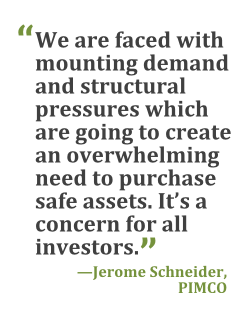Just because the Federal Reserve is about to raise interestrates, don't expect savers to benefit.
|Over the past six years, it's been practically impossible fordepositors and investors in money-market funds to keep up with thecost of living as the Fed slashed rates close to zero in anunprecedented bid to restore the U.S. economy.
|Now, savers counting on higher rates to lift returns are beingstymied by regulations designed to make the financial system safer.The rules are pushing firms to park more excess cash into Treasurybills that yield next to nothing, squeezing money-market funds thatbuy the short-term debt. JPMorgan Chase & Co. says demand willjump as much as US$900 billion in the next 18 months, equal toabout 60 percent of the total outstanding.
| “You've got the worst of all possible worlds for savers,”especially as inflation picks up, Christopher Sullivan, whooversees $2.4 billion as the chief investment officer at UnitedNations Federal Credit Union, said from New York.
“You've got the worst of all possible worlds for savers,”especially as inflation picks up, Christopher Sullivan, whooversees $2.4 billion as the chief investment officer at UnitedNations Federal Credit Union, said from New York.
The squeeze reflects yet another unintended consequence ofregulators' moves to limit risk-taking among financial firms in thewake of the credit crisis, which have already dried up liquidity indebt markets and encouraged investors to hoard.
|It also suggests that savers, particularly the 76 million babyboomers who are nearing retirement, may be deprived of much-neededincome long after the Fed starts to boost rates.
|Higher capital requirements mandated by the Basel Committee onBanking Supervision, which went into effect in January, have madeholding certain types of cash so costly some banks are adding feesto dissuade depositors.
|JPMorgan Chase, the largest U.S. bank, will charge hedge fundsand other institutions on deposits that aren't immediately requiredfor business as the New York-based lender tries to shed $100billion of deposits, chief financial officer Marianne Lake saidFeb. 24 in a presentation to investors.
|That cash is likely to wind up in Treasury bills and may pushrates on some of the short-term debt below zero, said Tyler Tucci,a U.S. government-bond strategist at Royal Bank of Scotland GroupPlc's RBS unit in Stamford, Connecticut.
|U.S. debt due in a year or less yielded 0.05 percent on Friday,index data compiled by Bank of America Corp. show.
|“If all this institutional cash is allocated to Treasury bills,we could potentially get our first look at a sustained move intonegative territory,” he said.
|Diminishing Returns
|That threatens to further depress returns in the $2.6 trillionmoney-market fund industry, which holds a sizable chunk of theultra-safe securities.
|Average yields for the biggest funds haven't topped 0.1 percentsince 2010, according to money-market researcher Crane Data LLC.Before 2008, they were closer to 5 percent.
|Tougher regulations in the market-market industry that start in2016 are also prompting some providers to convert higher-yieldingfunds into government-only investments.
|Fidelity Investments said in February that its Fidelity CashReserves Fund, the largest of its kind with more than $100 billion,will stop buying short-term debt issued by companies and transferassets to government securities.
||At the same time, the U.S. bill market itself will shrink $155billion during the second quarter as the U.S. issues just enoughdebt to meet redemptions, according to Citigroup Inc.
|“We are faced with mounting demand and structural pressureswhich are going to create an overwhelming need to purchase safeassets,” Jerome Schneider, the head of short-term strategies andmoney markets at Pacific Investment Management Co., which oversees$1.68 trillion, said from Newport Beach, California. “It's aconcern for all investors.”
|David Rosenberg, the chief economist at Gluskin Sheff &Associates in Toronto, says higher rates will ease some of the painthat savers have endured as a result of the Fed's extraordinarystimulus over the past six years.
|Traders are pricing in a 59 percent chance the central bank willstart raising its rate in September, while derivative marketsindicate it will peak at about 2.36 percent by December 2018.Rosenberg predicts the Fed will wait until next year and then liftfunding costs more aggressively.
|“The era of financial repression for ultra risk-averse investorsis drawing to a close,” he said. “Savers will ultimately have theirday. It's only a matter of time.”
|Rates on 12-month bills climbed to 0.26 percent on Monday, thehighest in four years, after a stronger-than-expected jobs reportstrengthened the case for the Fed to lift rates.
|Living Costs
|The rate was at 0.24 percent as of 11:55 a.m. in New York.
|Higher short-term rates on Treasuries may still not be enough tocompensate savers if the U.S. economy produces the kind of growththat spurs faster cost-of-living increases.
|While 12-month bill rates will climb to 1.2 percent in a year'stime, according to the forwards market, the problem is thatinflation may accelerate just as much, averaging 1.19 percent overthe coming year, based on swaps trading.
|Negative yields on debt in a dozen developed nations, includingGermany and Japan, will also lure bond buyers to the U.S. andcontain any selloff in Treasuries.
|“There is more cash that is seeking a home in high-qualityshort-term assets,” Andrew Hollenhorst, a fixed-income strategistat Citigroup, said from New York.
|Copyright 2018 Bloomberg. All rightsreserved. This material may not be published, broadcast, rewritten,or redistributed.
Complete your profile to continue reading and get FREE access to Treasury & Risk, part of your ALM digital membership.
Your access to unlimited Treasury & Risk content isn’t changing.
Once you are an ALM digital member, you’ll receive:
- Critical Treasury & Risk information including in-depth analysis of treasury and finance best practices, case studies with corporate innovators, informative newsletters, educational webcasts and videos, and resources from industry leaders.
- Exclusive discounts on ALM and Treasury & Risk events.
- Access to other award-winning ALM websites including PropertyCasualty360.com and Law.com.
*May exclude premium content
Already have an account? Sign In
© 2024 ALM Global, LLC, All Rights Reserved. Request academic re-use from www.copyright.com. All other uses, submit a request to [email protected]. For more information visit Asset & Logo Licensing.







